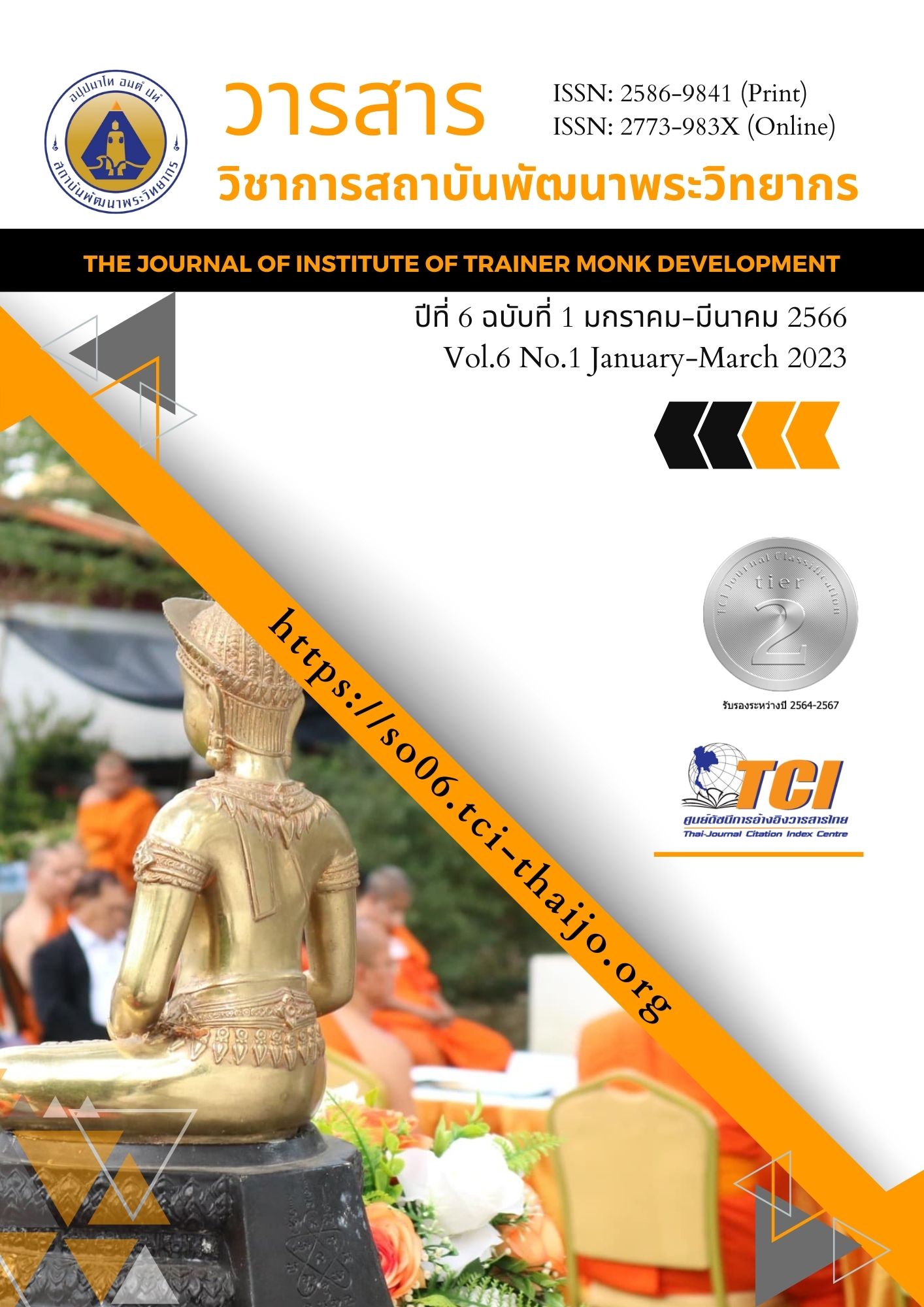Yonisomanasikara Thinking Affecting the Decision of Studying Graduate School Faculty of Education Mahachulalongkornrajavidyalaya University Ayutthaya
Main Article Content
Abstract
This Article aimed to study (1) the Yonisomanasikarn thinking and the decision of studying graduate school (2) Comparison of Yonisomanasikarn thinking and the decision of studying graduate school and (3) guideline to promote Yonisomanasikarn thinking affecting the decision of studying graduate school faculty of education, Mahachulalongkornrajavidyalaya University, Ayutthaya. The qualitative research sample, totaling 9 people and the quantitative research sample, are 80 students studying in the Master's Degree, Faculty of Education. The instrument for collecting data was interviews and questionnaires. Analysis data by Descriptive statistics and Content Analysis. The research results were found as follows;
1) Yonisomanasikarn thinking and decisions affecting decision making at the graduate level, it was found that the perception of truth and finding appropriate solutions to problems. The factors affecting students' admission to graduate studies were divided into 4 categories: 1. utilization factor, 2. financial factor, 3. readiness factor and 4. educational factor.
2) The results of comparing Yonisomanasikarn thinking and the decision of studying graduate school, it was found that age, career, and income were different, making the decision to study in graduate school Overall, there was a statistically significant difference at the 0.05 level.
3) The promotion guidelines are searching for factual information in the information about the educational institution you want to study. In addition, to publicize the details of the Faculty of Education curriculum. Identifying the extent of tuition costs Taking successful alumni as one of the role models to encourage decision-making to study at the graduate level of the Faculty of Education.
Article Details

This work is licensed under a Creative Commons Attribution-NonCommercial-NoDerivatives 4.0 International License.
บทความที่ได้รับการตีพิมพ์เป็นลิขสิทธิ์ของวารสารวิชาการสถาบันพัฒนาพระวิทยากร
ข้อความที่ปรากฎอยู่ในบทความที่ได้รับการตีพิมพ์ในวารสาร ถือเป็นความรับผิดชอบของผู้เขียนบทความ และข้อคิดเห็นนั้นไม่ถือว่าเป็นทัศนะและความรับผิดชอบของกองบรรณาธิการวารสารวิชาการสถาบันพัฒนาพระวิทยากร
References
กระทรวงศึกษาธิการ. (2562). ประกาศกระทรวงศึกษาธิการ เรื่อง นโยบายและจุดเน้นของกระทรวงศึกษาธิการ ปีงบประมาณ พ.ศ. 2564. กรุงเทพฯ: กระทรวงศึกษาธิการ.
กฤษณพงศ์ กีรติกร. (2558). อุดมศึกษาไทยเวทีไทยเวทีโลก. กรุงเทพฯ: สถาบันคลังสมองของชาติภายใต้มูลนิธิส่งเสริมทบวงมหาวิทยาลัย.
ไกรสิงห์ สุดสงวน. (2560). การศึกษาปัจจัยที่มีผลต่อการตัดสินใจศึกษาต่อในระดับอุดมศึกษาของนักเรียนมัธยมศึกษาตอนปลาย โรงเรียนสาธิตมหาวิทยาลัยศิลปากร. วารสารฉบับภาษาไทย สาขามนุษยศาสตร์ สังคมศาสตร์ และศิลปะ ปีที่ 10 ฉบับที่ 1: 201-207.
คณะครุศาสตร์ มหาวิทยาลัยมหาจุฬาลงกรณราชวิทยาลัย. (2565). หลักสูตรที่เปิดในการสอนในคณะครุศาสตร์ มหาวิทยาลัยมหาจุฬาลงกรณราชวิทยาลัย. สืบค้นเมื่อ 27 มกราคม 2565 จาก http://www.edu.mcu.ac.th/
คณะครุศาสตร์ มหาวิทยาลัยมหาจุฬาลงกรณราชวิทยาลัย. (2565). สถิตินิสิตคณะครุศาสตร์ ปีการศึกษา 2564. พระนครศรีอยุยา: มหาวิทยาลัยมหาจุฬาลงกรณราชวิทยาลัย.
พระพรหมคุณาภรณ์ (ป.อ.ปยุตโต). (2557). พุทธธรรม. พิมพ์ครั้งที่ 39. กรุงเทพฯ: โรงพิมพ์มหาจุฬาลงกรณราชวิทยาลัย.
มีสิทธิ ชัยมณี. (2559). การเลือกศึกษาต่อระดับปริญญาตรีของนักศึกษา คณะวิทยาศาสตร์และเทคโนโลยีมหาวิทยาลัยปทุมธานี. วารสารมหาวิทยาลัยปทุมธานี ปีที่ 1 ฉบับที่ 1: 97-107.
วีรวรรณ จงจิตรศิริจิรกาล และคณะ. (2557). ปัจจัยที่ส่งผลต่อการตัดสินใจเลือกเข้าศึกษาต่อระดับบัณฑิตศึกษามหาวิทยาลัยราชภัฏนครศรีธรรมราช. วิทยานิพนธ์การศึกษามหาบัณฑิต. บัณฑิตวิทยาลัย: มหาวิทยาลัยราชภัฏนครศรีธรรมราช.
ศศิมา สุขสว่าง. (2565). 7 ทักษะการคิด. สืบค้นเมื่อ 27 มกราคม 2565 จาก https://www.sasimasuk.com/16761107/7-7-thinking-skills
สถาบันวิจัยเพื่อการพัฒนาประเทศ (ทีดีอาร์ไอ). (2565). ทำอย่างไรนโยบาย
เลิกกำหนดเวลาเรียนจบ. สืบค้นเมื่อ 27 มกราคม 2565 จาก https://www.bangkokbiznews.com/columnist/980446
สะอาด ภิญโญศรี. (2552). การพัฒนาความสามารถด้านการคิดอย่างมีวิจารณญาณ ของนักเรียนชั้นมัธยมศึกษาปีที่ 2 กลุ่มสาระการเรียนรู้ภาษาไทย โดยใช้รูปแบบการสอนโยนิโสมนสิการ. วิทยานิพนธ์การศึกษามหาบัณฑิต. บัณฑิตวิทยาลัย: มหาวิทยาลัยมหาสารคาม.
เสรี สิงห์โงน. (2561). ปัจจัยที่มีผลต่อการตัดสินใจเลือกเข้าศึกษาต่อหลักสูตรวิทยาศาสตรมหาบัณฑิต สาขาวิชาจิตวิทยาเด็ก วัยรุ่นและครอบครัว มหาวิทยาลัยมหิดล. วารสาร Mahidol R2R e-Journal ปีที่ 3 ฉบับที่ 1: 95-108.


